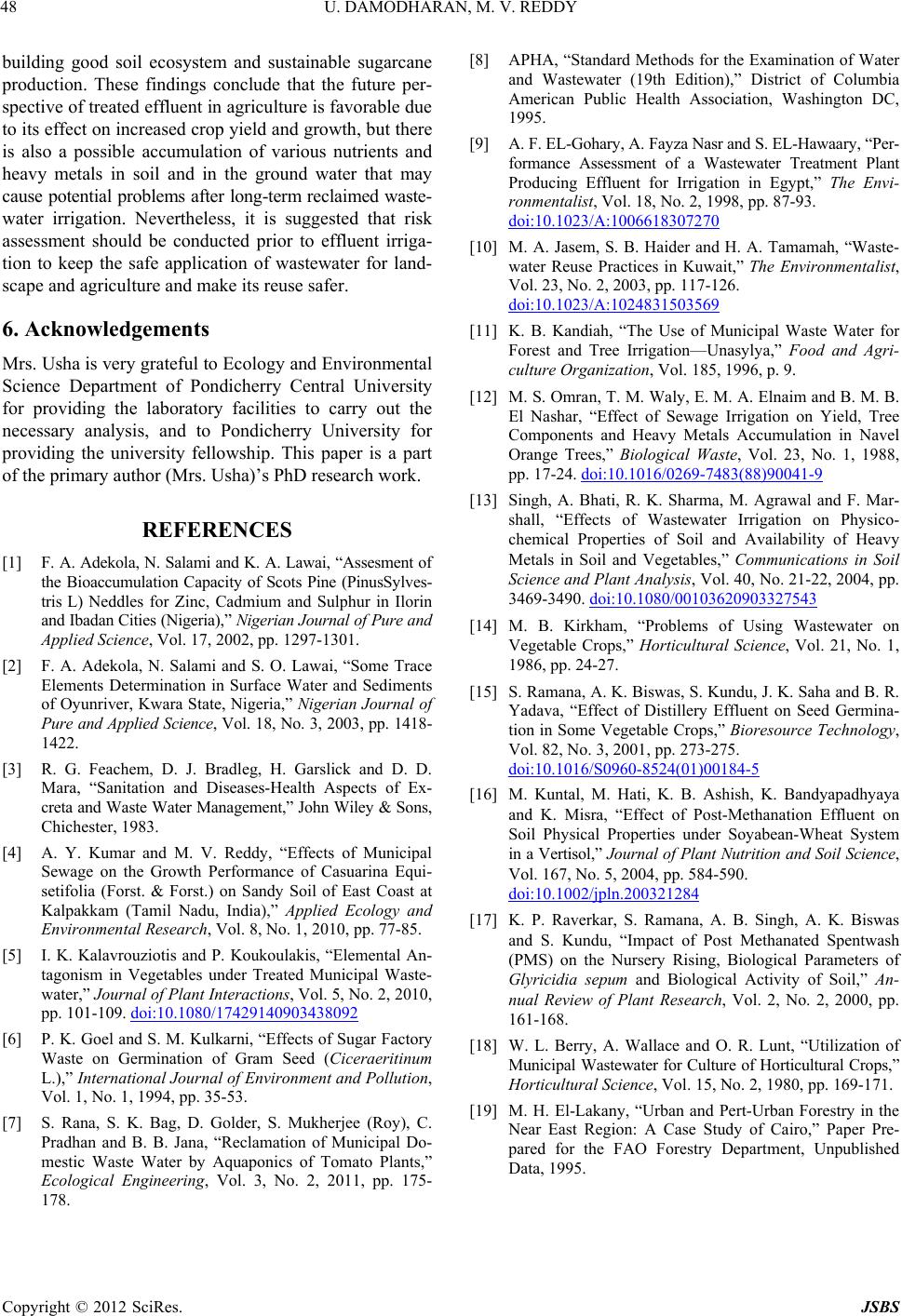
U. DAMODHARAN, M. V. REDDY
48
building good soil ecosystem and sustainable sugarcane
production. These findings conclude that the future per-
spective of treated effluent in agriculture is favorable due
to its effect on increased crop yield and growth, but there
is also a possible accumulation of various nutrients and
heavy metals in soil and in the ground water that may
cause potential problems after long-term reclaimed waste-
water irrigation. Nevertheless, it is suggested that risk
assessment should be conducted prior to effluent irriga-
tion to keep the safe application of wastewater for land-
scape and agriculture and make its reuse safer.
6. Acknowledgements
Mrs. Usha is very grateful to Ecology and Environmental
Science Department of Pondicherry Central University
for providing the laboratory facilities to carry out the
necessary analysis, and to Pondicherry University for
providing the university fellowship. This paper is a part
of the primary author (Mrs. Usha)’s PhD research work.
REFERENCES
[1] F. A. Adekola, N. Salami and K. A. Lawai, “Assesment of
the Bioaccumulation Capacity of Scots Pine (PinusSylves-
tris L) Neddles for Zinc, Cadmium and Sulphur in Ilorin
and Ibadan Cities (Nigeria),” Nigerian J ournal of Pure and
Applied Science, Vol. 17, 2002, pp. 1297-1301.
[2] F. A. Adekola, N. Salami and S. O. Lawai, “Some Trace
Elements Determination in Surface Water and Sediments
of Oyunriver, Kwara State, Nigeria,” Nigerian Journal of
Pure and Applied Science, Vol. 18, No. 3, 2003, pp. 1418-
1422.
[3] R. G. Feachem, D. J. Bradleg, H. Garslick and D. D.
Mara, “Sanitation and Diseases-Health Aspects of Ex-
creta and Waste Water Management,” John Wiley & Sons,
Chichester, 1983.
[4] A. Y. Kumar and M. V. Reddy, “Effects of Municipal
Sewage on the Growth Performance of Casuarina Equi-
setifolia (Forst. & Forst.) on Sandy Soil of East Coast at
Kalpakkam (Tamil Nadu, India),” Applied Ecology and
Environmental Research, Vol. 8, No. 1, 2010, pp. 77-85.
[5] I. K. Kalavrouziotis and P. Koukoulakis, “Elemental An-
tagonism in Vegetables under Treated Municipal Waste-
water,” Journal of Plant Interactions, Vol. 5, No. 2, 2010,
pp. 101-109. doi:10.1080/17429140903438092
[6] P. K. Goel and S. M. Kulkarni, “Effects of Sugar Factory
Waste on Germination of Gram Seed (Ciceraeritinum
L.),” International Journal of Environment and Pollution,
Vol. 1, No. 1, 1994, pp. 35-53.
[7] S. Rana, S. K. Bag, D. Golder, S. Mukherjee (Roy), C.
Pradhan and B. B. Jana, “Reclamation of Municipal Do-
mestic Waste Water by Aquaponics of Tomato Plants,”
Ecological Engineering, Vol. 3, No. 2, 2011, pp. 175-
178.
[8] APHA, “Standard Methods for the Examination of Water
and Wastewater (19th Edition),” District of Columbia
American Public Health Association, Washington DC,
1995.
[9] A. F. EL-Gohary, A. Fayza Nasr and S. EL-Hawaary, “Per-
formance Assessment of a Wastewater Treatment Plant
Producing Effluent for Irrigation in Egypt,” The Envi-
ronmentalist, Vol. 18, No. 2, 1998, pp. 87-93.
doi:10.1023/A:1006618307270
[10] M. A. Jasem, S. B. Haider and H. A. Tamamah, “Waste-
water Reuse Practices in Kuwait,” The Environmentalist,
Vol. 23, No. 2, 2003, pp. 117-126.
doi:10.1023/A:1024831503569
[11] K. B. Kandiah, “The Use of Municipal Waste Water for
Forest and Tree Irrigation—Unasylya,” Food and Agri-
culture Organization, Vol. 185, 1996, p. 9.
[12] M. S. Omran, T. M. Waly, E. M. A. Elnaim and B. M. B.
El Nashar, “Effect of Sewage Irrigation on Yield, Tree
Components and Heavy Metals Accumulation in Navel
Orange Trees,” Biological Waste, Vol. 23, No. 1, 1988,
pp. 17-24. doi:10.1016/0269-7483(88)90041-9
[13] Singh, A. Bhati, R. K. Sharma, M. Agrawal and F. Mar-
shall, “Effects of Wastewater Irrigation on Physico-
chemical Properties of Soil and Availability of Heavy
Metals in Soil and Vegetables,” Communications in Soil
Scie nce an d Plant Anal ysi s, Vol. 40, No. 21-22, 2004, pp.
3469-3490. doi:10.1080/00103620903327543
[14] M. B. Kirkham, “Problems of Using Wastewater on
Vegetable Crops,” Horticultural Science, Vol. 21, No. 1,
1986, pp. 24-27.
[15] S. Ramana, A. K. Biswas, S. Kundu, J. K. Saha and B. R.
Yadava, “Effect of Distillery Effluent on Seed Germina-
tion in Some Vegetable Crops,” Bioresource Technology,
Vol. 82, No. 3, 2001, pp. 273-275.
doi:10.1016/S0960-8524(01)00184-5
[16] M. Kuntal, M. Hati, K. B. Ashish, K. Bandyapadhyaya
and K. Misra, “Effect of Post-Methanation Effluent on
Soil Physical Properties under Soyabean-Wheat System
in a Vertisol,” Journal of Plant Nutrition and Soil Science,
Vol. 167, No. 5, 2004, pp. 584-590.
doi:10.1002/jpln.200321284
[17] K. P. Raverkar, S. Ramana, A. B. Singh, A. K. Biswas
and S. Kundu, “Impact of Post Methanated Spentwash
(PMS) on the Nursery Rising, Biological Parameters of
Glyricidia sepum and Biological Activity of Soil,” An-
nual Review of Plant Research, Vol. 2, No. 2, 2000, pp.
161-168.
[18] W. L. Berry, A. Wallace and O. R. Lunt, “Utilization of
Municipal Wastewater for Culture of Horticultural Crops,”
Horticultural Science, Vol. 15, No. 2, 1980, pp. 169-171.
[19] M. H. El-Lakany, “Urban and Pert-Urban Forestry in the
Near East Region: A Case Study of Cairo,” Paper Pre-
pared for the FAO Forestry Department, Unpublished
Data, 1995.
Copyright © 2012 SciRes. JSBS